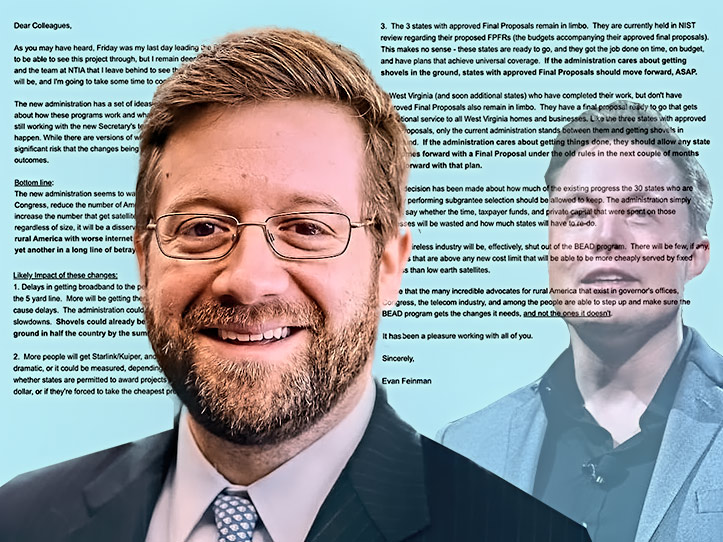
INCREASED USE OF SATELLITES CONCERN – Despite BEAD’s current prioritization of fiber, Evan Feinman expects a push toward greater reliance on satellite broadband, particularly low-earth-orbit systems like Starlink and Amazon’s Kuiper, which are overshadowing the program’s fiber-centric approach.
The $42.5 billion Broadband Equity, Access, and Deployment (BEAD) program is at a crossroads following the departure of its director, Evan Feinman. In a farewell email to staff (available below), Feinman issued a stark warning that proposed shifts in the program’s direction—moving away from fiber broadband infrastructure in favor of satellite-based alternatives—could result in “deeply negative outcomes” for rural America.
Feinman’s tenure ended without reappointment, coinciding with Commerce Secretary Howard Lutnick’s announcement of a “rigorous review” of the program, which he criticized for its slow implementation. Lutnick pointed to what he called “woke mandates, favoritism towards certain technologies, and burdensome regulations” as key reasons for BEAD’s sluggish progress, asserting that the program “has not connected a single person to the internet.”
Shifting priorities: Fiber to satellite?
BEAD, a key component of the $1 trillion bipartisan infrastructure bill, was designed to provide grants to states to build internet infrastructure capable of delivering at least 100 Mbps download and 20 Mbps upload speeds to underserved areas. The program prioritizes fiber broadband, the gold standard for high-speed internet, while allowing other technologies in cases where fiber is not viable.
However, Lutnick’s review appears poised to change that focus. His potential reforms could favor low-earth-orbit satellite providers, such as Elon Musk’s Starlink, over fiber networks. According to a March report from The Wall Street Journal, the initial rules could have allowed Starlink to receive up to $4.1 billion in BEAD funding. Under Lutnick’s revisions, that figure could balloon to as much as $20 billion.
Feinman sharply criticized this shift in his farewell message, arguing that it would leave “all or part of rural America with worse internet so that we can make the world’s richest man even richer.” He categorized the proposed changes as “yet another in a long line of betrayals by Washington.”
Key concerns and expected changes
In his email, Feinman outlined several anticipated changes that he believes will reshape the program’s implementation:
Regulatory Rollbacks: Removal of provisions related to labor wages, climate resiliency, and affordability measures for middle-class households. Feinman downplayed their direct impact on the program, calling them “messaging/political provisions,” but acknowledged their removal.
A “Pause” That Isn’t a Pause: While the administration does not want to be seen as stalling the program, Feinman suggests that states may be forced to slow down or halt their selection of subgrantees.
Per-Location Spending Limits: Potential cost caps per household for broadband expansion. While not necessarily problematic, Feinman warned that an overly restrictive approach could hinder effective service in remote areas.
Increased Use of Satellites: Despite BEAD’s legal requirement to prioritize fiber, Feinman expects a push toward greater reliance on satellite broadband, particularly low-earth-orbit systems like Starlink and Amazon’s Kuiper.
Delays and disruptions for states
Feinman also predicted major delays in broadband deployment, with some states already nearing completion of their subgrantee selection process. “Shovels could already be in the ground in three states, and they could be in the ground in half the country by the summer without the proposed changes to project selection,” he wrote.
Three states—Delaware, Louisiana, and Nevada—had reached the final proposal stage before updates to the government’s BEAD tracking site ceased. Meanwhile, states like West Virginia, which have completed their broadband proposals, remain in limbo as they await final approvals. Feinman urged the administration to allow states with completed proposals to move forward without delay.
Additionally, uncertainty surrounds the fate of 30 states that have already begun selecting subgrantees. The administration has not clarified whether previous work and investments will be honored or if states will be forced to restart the process.
Partisan battle over BEAD’s future
The policy shift is already drawing political scrutiny. Republicans have long criticized the Biden administration for excluding Starlink from BEAD for political reasons, a claim the FCC has denied. In 2023, the agency rejected Starlink’s bid for an $886 million subsidy under a separate broadband expansion program, stating that the company had failed to prove it could consistently deliver the promised service.
If Lutnick’s proposed revisions move forward, Starlink stands to gain significantly. Critics argue that prioritizing satellite internet over fiber could lead to lower-quality service in rural communities, exacerbating the digital divide rather than closing it.
What’s next?
As Feinman exits and new leadership takes over, the BEAD program’s future remains uncertain. His final message urged broadband advocates, state officials, and industry leaders to push back against changes that could undermine the program’s mission.
“I hope that the many incredible advocates for rural America that exist in governor’s offices, Congress, the telecom industry, and among the people are able to step up and make sure the BEAD program gets the changes it needs—and not the ones it doesn’t,” he concluded.
The debate over fiber versus satellite, regulatory oversight, and broadband accessibility is far from over. For now, millions of Americans in rural and underserved areas are left waiting to see whether BEAD will fulfill its original promise or take a drastically different approach.
Feinman’s Farewell Letter
Dear Colleagues,
As you may have heard, Friday was my last day leading the BEAD program. I am disappointed not to be able to see this project through, but I remain deeply proud of the work we got done together and the team at NTIA that I leave behind to see the job through. I don’t know what my next chapter will be, and I’m going to take some time to consider that.
The new administration has a set of ideas about where they want to go, but they are still learning about how these programs work and what the law says. As a result, they, and the staff at NTIA, are still working with the new Secretary’s team on how getting ‘the benefit of the bargain’ will actually happen. While there are versions of what has been proposed that are benign, there is also significant risk that the changes being proposed will be ill-considered and create deeply negative outcomes.
Bottom line:
The new administration seems to want to make changes that ignore the clear direction laid out by Congress, reduce the number of American homes and businesses that get fiber connections, and increase the number that get satellite connections. The degree of that shift remains unknown, but regardless of size, it will be a disservice to rural and small-town America. Stranding all or part of rural America with worse internet so that we can make the world’s richest man even richer is yet another in a long line of betrayals by Washington.
Likely Impact of these changes:
1. Delays in getting broadband to the people. Some states are on the 1 yard line. A bunch are on the 5 yard line. More will be getting there every week. These more-sweeping changes will only cause delays. The administration could fix the problems with the program via waiver and avoid slowdowns. Shovels could already be in the ground in three states, and they could be in the ground in half the country by the summer without the proposed changes to project selection.
2. More people will get Starlink/Kuiper, and fewer people will get fiber connections. This could be dramatic, or it could be measured, depending on where the administration sets the threshold limit, and whether states are permitted to award projects above the new threshold on the basis of value per dollar, or if they’re forced to take the cheapest proposal, even if it provides poorer service.
3. The 3 states with approved Final Proposals remain in limbo. They are currently held in NIST review regarding their proposed FPFRs (the budgets accompanying their approved final proposals). This makes no sense – these states are ready to go, and they got the job done on time, on budget, and have plans that achieve universal coverage. If the administration cares about getting shovels in the ground, states with approved Final Proposals should move forward, ASAP.
4. West Virginia (and soon additional states) who have completed their work, but don’t have approved Final Proposals also remain in limbo. They have a final proposal ready to go that gets exceptional service to all West Virginia homes and businesses. Like the three states with approved Final Proposals, only the current administration stands between them and getting shovels in the ground. If the administration cares about getting things done, they should allow any state that comes forward with a Final Proposal under the old rules in the next couple of months move forward with that plan.
5. No decision has been made about how much of the existing progress those 30 states who are already performing subgrantee selection should be allowed to keep. The administration simply cannot say whether the time, taxpayer funds, and private capital that were spent on those processes will be wasted or how much states will have to re-do.
6. The Wireless industry will be, effectively, shut out of the BEAD program. There will be few, if any, locations that are above any new cost limit that will be able to be more cheaply served by fixed wireless than low earth satellites.
I hope that the many incredible advocates for rural America that exist in governor’s offices, Congress, the telecom industry, and among the people are able to step up and make sure the BEAD program gets the changes it needs, and not the ones it doesn’t.
It has been a pleasure working with all of you.
Sincerely,
Evan Feinman

















